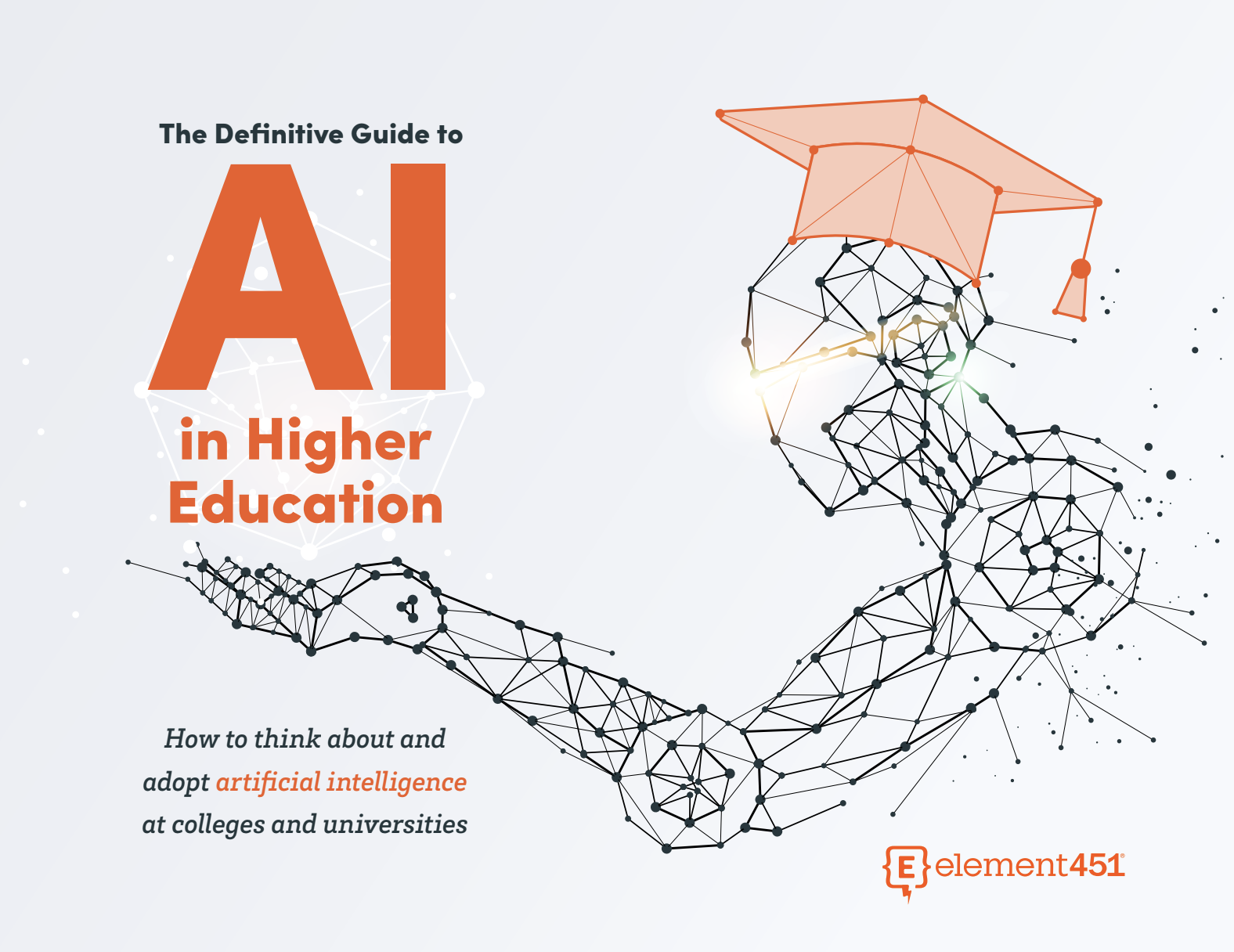Higher Ed Admission Trends Shaping the Future of Enrollment
by Erin Newton · Updated Dec 22, 2024
Although colleges and universities have to plan and invest in many different areas of student life and engagement, admissions remains a top priority. A reliable pipeline of incoming students keeps higher education institutions financially healthy.
A strong admissions strategy is built on a keen understanding of the current admissions climate. In this post, we’ll introduce some of the top factors and the latest college admissions trends for college campuses around the country.

Higher Ed Admission Trends
Regardless of whether you have a vested interest in admissions or if you’re the one creating a full-fledged admissions strategy, it’s crucial to know where you stand.
Recruiting, admissions, and enrollment are all quickly changing in their own unique ways. It’s time to adapt and learn in order to reach more students with effective and compelling messaging.
1. Direct Admissions
Direct admissions programs are those that accept new students based on a standardized application or test evaluation alone. In a direct model, the entire application is simplified so that students have fewer steps to complete throughout the admissions journey.
Schools that implement direct admissions policies may find success in reaching more diverse student populations and in enrolling high-priority students faster. This strategy can help you get the right students enrolled without extra “red tape” or prequalifications.
2. Test-Optional Policies
Past generations might remember the importance (and stress) of having excellent test scores in order to move forward in the college admissions process. But now, more schools than ever are moving to a test-optional admissions process, which greatly affects high school students and high school graduates.
Although this trend became more prominent during the height of the COVID-19 pandemic, over 60% of all schools now have optional SAT and ACT policies. This is a huge change for future generations of incoming students.
For students who still opt to take these important exams, higher scores can help applicants stand out from the rest of an incoming class.
3. Global Enrollment Recovery
The coronavirus pandemic had a massive impact on international student enrollment, with a sharp percentage drop in international admissions across the board. U.S. News and World Report shares that international enrollment fell by over 45% in 2020.
Although the number of new international students is not back to where it was in a pre-pandemic time, this number is rebounding with each successive academic year. Studying in the U.S. is still an appealing choice that offers numerous incentives, both personally and academically.
Schools and admissions offices should remain active and committed to helping international students apply to academic programs and find the right fit. With support and guidance, international student numbers may see a boost within the next few semesters, particularly at schools that prioritize international enrollment.
4. Diversity and Inclusion Focus
With current events and cultural concerns, many high school seniors are looking to attend a future school that values equality. Within the admissions process, students are seeking affirmation that under-represented groups are both safe and welcome.
Reports from sources like CommonApp, a platform for streamlined college applications, also show that there has been an uptick in the number of applications from first-generation students and from those with underprivileged socioeconomic backgrounds. In fact, first-generation students make up one-third of all students attending college.
These trends demonstrate the need for colleges and universities to remain places of respite and inclusion for incoming students—regardless of background or beliefs. Not only do incoming applicants have a demonstrated interest in new academic experiences, but they want to do so in a diverse, collaborative, and valuable environment. Inclusivity is a very important guiding metric in 2023.
5. Yield Protection
As colleges move past the predictable COVID-19 enrollment dips, many higher education forecasters are predicting record numbers of new applicants in upcoming academic terms. While this is often a benefit for schools looking to make a rebound, it makes the applicant pool more competitive and narrow for students.
Institutions must be able to effectively navigate the different responses to early decision and regular decision timelines. For many schools that need to fill seats (without giving most away to “Early Decision” attendees), yield protection is becoming commonplace when working with prospective students.
Yied protection refers to the practice of turning away or deferring high-performing applicants who may be more likely to attend another school once accepted. This process means that schools are more likely to award acceptance to the students most likely to enroll.
6. Holistic Admissions
As more schools move away from test scores, legacy acceptance policies, and other academic merits, the “human” side of undergraduate enrollment is becoming a focal point.
Higher ed institutions are increasingly interested in the interpersonal backgrounds and unique qualities of each student prior to enrollment.
For students, this means that things like essays and interviews will take on more importance throughout the college application process. Applicants must put their best writing and communication skills on display in order to make a strong first impression. Test-optional schools are most likely to adopt these policies.
From a school’s perspective, this means providing every student with a fair opportunity. As admissions moves beyond AP test scores or ACT scores to decide what is “good or bad,” they must be willing to compensate with objective policies for admissions decisions.
7. AI and Technology Integration
The integration of artificial intelligence (AI) and advanced technologies is reshaping higher education admissions. Institutions are adopting AI-driven tools to enhance application evaluations, personalize student communications, and streamline administrative tasks. These technologies offer significant benefits, including increased efficiency and the potential to reduce human biases in admissions decisions.
However, the rise of AI also raises concerns about ethical implications and the need for transparency. As these tools become more embedded in higher education, both students and institutions must adapt to ensure that AI enhances accessibility and maintains fairness in the admissions process.
8. End of Legacy Preferences
Legacy admissions, which give preference to applicants with familial ties to alumni, are facing increased scrutiny and challenges. Critics argue that this practice perpetuates inequities by favoring affluent, often white, applicants, thereby hindering diversity and access for underrepresented groups. In response, several institutions have voluntarily ended legacy preferences, and momentum for change continues to grow.
Public opinion increasingly reflects a call for fairness, with many advocating for admissions policies that prioritize merit and inclusivity. By eliminating legacy preferences, higher education institutions are taking critical steps toward leveling the playing field and fostering a more equitable admissions landscape.
Factors That Affect College Admissions
Below are some of the key elements that play a role in shaping admissions outcomes:
- New Student Applicants
The number of prospective students applying to a college significantly impacts admissions outcomes. Institutions closely monitor trends in applications, particularly for incoming freshmen, to gauge interest and plan accordingly. - Financial Aid Challenges
The availability of financial aid plays a critical role in shaping enrollment decisions. Rising tuition costs and limited aid resources can deter students from applying or enrolling, making it essential for institutions to address affordability concerns. - Streamlined Admissions
An efficient and user-friendly admissions process is more important than ever. Simplifying application procedures can reduce barriers for students, increasing the likelihood of completed applications and enrollments. - Competition Level
The competitiveness of a college’s admissions process affects both applicants and institutions. Factors like selectivity, academic requirements, and peer comparisons influence which schools students prioritize. - Recruitment Efforts
Strong recruitment and marketing efforts are vital for driving interest among prospective students. From digital campaigns to personalized outreach, the effectiveness of these strategies can determine whether students apply or enroll. - Student Preferences
Student priorities are constantly evolving. Preferences around location, academic programs, campus culture, and extracurricular opportunities heavily influence their decision-making process. - College Value Perceptions
How students and families perceive the value of a degree from a specific institution can significantly impact admissions numbers. Schools must clearly articulate their return on investment through outcomes like job placement rates, alumni success, and campus resources.
By understanding and addressing these factors, colleges and universities can better navigate the complex and competitive landscape of modern admissions.
The Power of a Student Engagement CRM
A comprehensive student engagement CRM is an extremely beneficial tool in a world of shifting admissions cycles. Not only does strong and reliable data remain the same (regardless of what other trends come and go), but it provides a baseline for admissions and enrollment staff to make the most informed decisions possible.
Accurate and real-time student data can also make the admissions and enrollment journey highly personalized and unique. As students (and their families) become more digitally aware, it will be necessary to improve digital processes, brand messaging, and user experiences. These efforts can go a long way in communicating the rich value of an institution.
Redefining Student Admissions
The landscape of higher education admissions continues to evolve, driven by trends like AI integration, the end of legacy preferences, and shifting student priorities. Colleges and universities must remain adaptable, leveraging technology and data to enhance accessibility and fairness. At the same time, institutions must address challenges such as financial aid limitations and heightened competition, all while staying attuned to the changing needs of prospective students.
By understanding the factors that shape admissions—from recruitment efforts to college value perceptions—institutions can position themselves for success. The future of admissions lies in balancing innovation with empathy, ensuring every student has the opportunity to thrive.
Frequently Asked Questions
What is the future of higher education?
The future of higher education is increasingly influenced by technology, accessibility, and a focus on meeting student and workforce demands. Adaptation will be key for success.
What is the biggest problem in higher education?
Rising tuition costs and financial aid gaps remain significant challenges, creating barriers to access and equity for many students.
What is the hot topic in higher education in 2024?
AI's role in admissions and education is a major topic, as institutions navigate its potential benefits and ethical implications.

About Element451
Boost enrollment, improve engagement, and support students with an AI workforce built for higher ed. Element451 makes personalization scalable and success repeatable.
Categories
New Blog Posts

The Definitive Guide
AI in Higher Education
Bridge the gap between the latest tech advancements and your institution's success.
Useful Links
Related Articles

Talk With Us
Element451 is the only AI Workforce Platform for higher education. Our friendly experts are here to help you explore how Element451 can improve outcomes for your school.
Get a Demo









